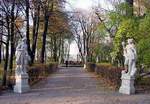|
|
|
Attractions in St. Petersburg
|  | |
THE SUMMER GARDENS
| |

| |
The Summer Gardens are almost as old as the city. It might date back to the early 1704, when on the order of Peter I they started to bring saplings of various trees, flower seeds, marble statues, columns, etc. to Petersburg from all parts of Russia and Europe. By 1707 much of the work on laying out the gardens, planting the trees and setting up the fountains had been completed.
It was a regular garden with a geometrical pattern of crossing alleys and with trimmed shrubs, symmetrically arranged statues and fountains. In the early 18th century the Summer Gardens occupied a much larger territory: from the Neva bank and almost reaching Nevsky Prospekt.
In the 1720s the Lebiazhya (Swan) Kanavka was laid that separated the Summer Gardens from the Field of Mars; the Mya (Moika) River was deepened and connected with the Fontanka. Thus the Summer Gardens surrounded by the Neva, Fontanka, Moika and Lebiazhya Kanavka became an island.
The Summer Palace of Peter I was small and not suited for large receptions; so in summer court festivities and receptions were held in the garden alleys. Dinners were given in the galleries on the Neva bank built especially for this purpose. There were many other entertainments in the garden, including pavilions, a grotto, curvy paths, a maze, etc. The contemporaries left a lot of descriptions testifying of its extraordinary beauty and luxury.
According to the tsar's directions statues were bought or ordered in Europe, especially in Venice, famous for its sculptors. The 250 sculptures decorating the garden make up a genuinely unique collection of Italian Baroque sculpture, performed by P.Baratta, D.Bonazza, F.Cabianca and others. In 1773 - 86 the famous railing was put up on the side facing the Neva (architects Yu.Velten, P.Yegorov).
The terrible storm and flood of 1777 caused the Summer Gardens irreparable damage: the fountain system was wrecked, many statues were lost or damaged, the maze destroyed, a lot of trees pulled out. After this disaster the former decoration was never restored, and the Imperial summer residence was moved to the suburbs. In the 19th century the Gardens became open to the public (with the exclusion of the "common people").
Address: Letniy Sad.
|
|
|
|
 |
|
 |
 |
|
|
 |
 |



